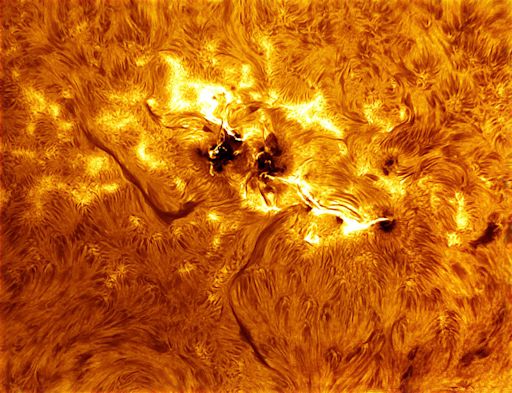APPROACHING CME: NOAA forecasters estimate a 25% chance of polar geomagnetic storms on Feb. 4th when a CME is expected to sideswipe Earth's magnetic field. The glancing impact could spark auroras around the Arctic Circle. Aurora alerts: text, voice
CHANCE OF FLARES: NOAA forecasters estimate an 80% chance of M-flares and a 50% chance of X-flares on Feb. 4th. The source would be giant sunspot AR1967, shown here seething with activity in a photo from amateur astronomer Sergio Castillo of Inglewood, California:
In Castillo's photo, a pair of magnetic filaments reaches out from the heart of the active region, where multiple dark cores big enough to swallow Earth are crackling with flares. "The activity in this region is just amazing," says Castillo.
AR1967 has an unstable 'delta-class' magnetic field that harbors energy for strong flares and CMEs. Any eruptions today will surely be Earth-directed as the active region crosses the center of the solar disk. Solar flare alerts: text, voice
Realtime Space Weather Photo Gallery
MUST-SEE AURORA MOVIE: "We are enjoying one of our best years ever," reports Chad Blakley, an aurora tour guide in Sweden's Abisko National Park. "So far we have seen auroras on 29 out of the 31 nights we have looked. Last night was extra special. The sky exploded in color and I was lucky to capture the phenomenon with several different cameras from multiple angles." Click to view the resulting footage:
"The lights were so powerful that the images became overexposed with a shutter speed of less than one second," he continues. "I can honestly say that this was one of the greatest displays of natural beauty that I have ever seen."
The show is apt to continue tonight. NOAA forecasters estimate a 25% chance of geomagnetic storms on Feb. 3-4 when an approaching CME is expected to deliver a glancing blow to our planet's magnetic field. Aurora alerts: text, voice

Solar wind
speed: 337.9 km/sec
density: 2.5 protons/cm3
explanation | more data
Updated: Today at 1647 UT
X-ray Solar Flares
6-hr max: M1 1535 UT Feb04
24-hr: M5 0400 UT Feb04
explanation | more data
Updated: Today at: 1600 UT
![]()
Daily Sun: 04 Feb 14
Earth-facing sunspot AR1967 has a 'beta-gamma-delta' magnetic field that harbors energy for X-class solar flares. Credit: SDO/HMI
![]()
Sunspot number: 168
What is the sunspot number?
Updated 04 Feb 2014
Spotless Days
Current Stretch: 0 days
2014 total: 0 days (0%)
2013 total: 0 days (0%)
2012 total: 0 days (0%)
2011 total: 2 days (<1%)
2010 total: 51 days (14%)
2009 total: 260 days (71%)
Update 04 Feb 2014
The Radio Sun
10.7 cm flux: 188 sfu
explanation | more data
Updated 04 Feb 2014
![]()
Current Auroral Oval:
Switch to: Europe, USA, New Zealand, Antarctica
Credit: NOAA/POES
![]()
Planetary K-index
Now: Kp= 1 quiet
24-hr max: Kp= 2 quiet
explanation | more data
Interplanetary Mag. Field
Btotal: 6.6 nT
Bz: 2.4 nT south
explanation | more data
Updated: Today at 1557 UT
![]()
Coronal Holes: 04 Feb 14
A solar wind stream flowing from the indicated coronal hole should reach Earth on or about Feb. 9th. Credit: SDO/AIA.






